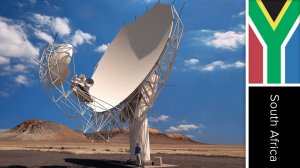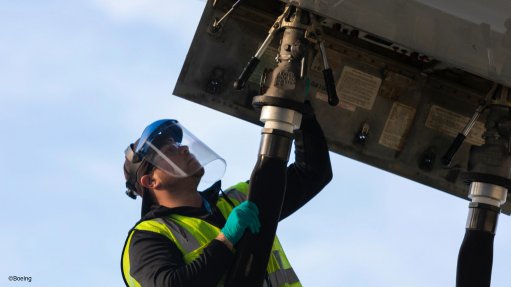MeerKAT telescope project, South Africa
Name and Location
MeerKAT telescope project, Northern Cape, South Africa.
Client
The Square Kilometre Array South Africa (SKA SA) is the agency that drove South Africa’s bid to host the €1.5-billion international SKA radio telescope and the MeerKAT programme.
Project Description
South Africa’s MeerKAT radio telescope array is intended to be a precursor of the international SKA radio telescope. The MeerKAT evolved from the original idea of a Karoo Array Telescope (KAT).
The reference design specification for the full MeerKAT is 64 offset dishes, each with a diameter of 13.5 m, with single-pixel wideband feeds covering the 500 MHz to 2.5 GHz frequency range. The design means that there are no struts over the dish, which can reduce or scatter incoming radio waves, thus increasing the sensitivity of the antenna.
The completed MeerKAT will have a central core, but some dishes are almost 10 km apart, thus replicating the SKA on a small scale.
It will also facilitate the installation of multiple receiver systems in the primary and secondary focal areas and is the reference design for the midband SKA concept.
The MeerKAT will be delivered in three phases.
The first phase – the MeerKAT Precursor Array, known as KAT-7 and which comprises seven 12-m-diameter composite parabolic dishes at the Karoo site – was completed in 2010.
This prototype interferometer array serves as an engineering test-bed for technologies and systems and as an operational radio telescope. MeerKAT is designed to be integrated into the SKA radio telescope, which will be cohosted by South Africa and Australia.
Value
The estimated cost is R900-million.
Duration
The commissioning of MeerKAT is scheduled for 2014/15, with the array coming on line for science operations in 2016. This phase includes all antennas, but only the first receiver will be fitted, and a processing bandwidth of 750 MHz will be available.
For MeerKAT Phase 2 and Phase 3, the remaining two receivers will be fitted and the processing bandwidth will be increased to at least 2 GHz, and later to 4 GHz.
Latest developments
South African Science and Technology Minister Naledi Pandor has announced that the MeerKAT will be ready for science by the end of June this year. By then, 21 antennas will have been mounted and ready.
At the end of April, using four antennas, MeerKAT obtained its first image of a pulsar. This was important with regard to the design, development, engineering, construction and operation of the instrument. “It showed we’re on the right track,” SKA SA director Dr Rob Adam has noted.
“We’re going flat out to have a scientifically competitive array by the end of June. This will initially use 16 antennas, even though more than 21 will have been erected by then. After an antenna has been erected, it must be calibrated and then integrated into the array. It can’t just be switched on and put to use. By the end of this year, we’re targeting a 32-dish array. “That would make MeerKAT the largest array of its type in the world. It would be larger than the 27-dish Karl G Jansky Very Large Array in New Mexico.”
A MeerKAT Science Workshop will be held to recalibrate the various large sky survey projects agreed upon for the instrument. This recalibration is necessary because MeerKAT’s performance is going to be better than originally planned. “We’ve recalibrated the antennas beyond their specification – they’re more capable than originally intended.”
As for the SKA, SKA SA has been authorised by South Africa’s Ministers of Finance and Science and Technology to start buying land for the core site of SKA Phase 1. “These purchases are subject to negotiation,” reported SKA SA director Dr Rob Adam at the Third SKA African Partner Countries Ministerial Meeting. “We will certainly be ready for construction, to begin in 2018.”
During Phase 2 of the SKA programme, outstations will be established in several other countries. The SKA African partner countries will each host at least one outstation. South Africa and the eight SKA African partner countries are also partners in the African Very Long Baseline Interferometry Network (AVN), being developed under the leadership of SKA SA with South African expertise. At the Ministerial meeting, a memorandum of understanding for institutionalising cooperation in radio astronomy, including the SKA and African Very Long Baseline Interferometry Network between South Africa and the other SKA African partner countries, was approved.
Key Contracts and Suppliers
Group Five Coastal (building foundations); Schneider Electric South Africa (building management system); Stratosat Datacom (part of Germany’s Schauenburg Group), with its technology partners, General Dynamics Satcom, of the US, and Vertex Antennentechnik, of Germany (design, construction, installation and commissioning of antennas); Efficient Engineering (antenna pedestals and yokes); Tricom Structures (backup structures for dishes); Titanus Slew Rings (main azimuth bearings); National Research Council of Canada (low-noise amplifiers); Oxford Cryosystems (cryogenic cooling system) and Brink & Heath Civils (foundations), Max-Planck-Society and Max Planck Institute for Radio Astronomy (S-band radio- wave receivers).
On Budget and on Time?
The project is on schedule.
Contact Details for Project Information
MeerKAT engineering office, tel +27 21 506 7300 or fax +27 21 506 7375.
Group Five Coastal, tel +27 31 5690300 or fax +27 31 569 0420.
Schneider Electric South Africa, tel +27 11 254 6400,
fax +27 11 254 6700/4 or email enquiries@za.schneider-electric.com.
Stratosat Datacom, tel +27 11 974 0006 or fax +27 11 974 0068.
General Dynamics Satcom technologies, tel +1 828 464 4141, fax +1 828 464 4147 or email info@gdsatcom.com.
Brink & Heath Civils, tel +27 21 551 2640, fax +27 21 551 2977 or email admin@brinkheath.co.za.
Efficient Engineering, tel +27 11 928 4800, fax +27 11 974 8719 or email info@efficient.co.za.
Tricom Structures, tel +27 12 803 0041, fax +27 12 803 6040 or email info@tricom1.co.za.
Titanus Slew Rings, tel +27 11 974 7017 or fax + 27 11 974 8109.
National Research Council of Canada, tel +1 613 993 9101, fax +1 613 952 9907 or email info@nrc-cnrc.gc.ca.
Oxford Cryosystems, tel +44 1993 883 488.
Max-Planck-Society, tel +49 89 2108-1275 or email beck@gv.mpg.de.
Max Planck Institute for Radio Astronomy, tel +49 228 5250 or fax +49 228 525 229.
Comments
Press Office
Announcements
What's On
Subscribe to improve your user experience...
Option 1 (equivalent of R125 a month):
Receive a weekly copy of Creamer Media's Engineering News & Mining Weekly magazine
(print copy for those in South Africa and e-magazine for those outside of South Africa)
Receive daily email newsletters
Access to full search results
Access archive of magazine back copies
Access to Projects in Progress
Access to ONE Research Report of your choice in PDF format
Option 2 (equivalent of R375 a month):
All benefits from Option 1
PLUS
Access to Creamer Media's Research Channel Africa for ALL Research Reports, in PDF format, on various industrial and mining sectors
including Electricity; Water; Energy Transition; Hydrogen; Roads, Rail and Ports; Coal; Gold; Platinum; Battery Metals; etc.
Already a subscriber?
Forgotten your password?
Receive weekly copy of Creamer Media's Engineering News & Mining Weekly magazine (print copy for those in South Africa and e-magazine for those outside of South Africa)
➕
Recieve daily email newsletters
➕
Access to full search results
➕
Access archive of magazine back copies
➕
Access to Projects in Progress
➕
Access to ONE Research Report of your choice in PDF format
RESEARCH CHANNEL AFRICA
R4500 (equivalent of R375 a month)
SUBSCRIBEAll benefits from Option 1
➕
Access to Creamer Media's Research Channel Africa for ALL Research Reports on various industrial and mining sectors, in PDF format, including on:
Electricity
➕
Water
➕
Energy Transition
➕
Hydrogen
➕
Roads, Rail and Ports
➕
Coal
➕
Gold
➕
Platinum
➕
Battery Metals
➕
etc.
Receive all benefits from Option 1 or Option 2 delivered to numerous people at your company
➕
Multiple User names and Passwords for simultaneous log-ins
➕
Intranet integration access to all in your organisation





















